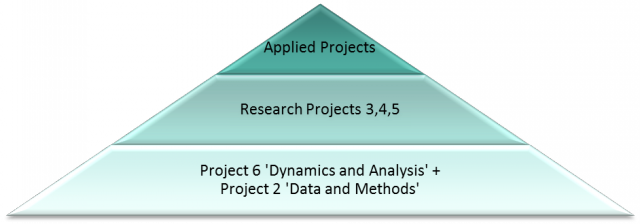Project 6 – Dynamics Analysis
Short Description
Main purpose of project Dynamics and Analysis was the analysis and preparation of fundamental research for all other five projects. Hence, contrary to the other projects, the outcome of the project does not consist of fully parameterised products, but rather theoretical methods. These did not only play a crucial supplementary role for the other projects but are also of very high scientific value. Thus the content of the project was not only extremely broad, but also reached deep into foundational science of mathematics and medical science to work with the current state of the art.
Project Outcome
Dynamics Analysis answered following questions:
-
How can we determine, whether correlated statistical data is based on a real causal relationship?
An “increasing Fox population” will almost surely lead to a „decay of the hare“ and a “decay of the pheasant” population. Yet neither the “decay of hare” causes the “decay of pheasant” population not vice versa. Thus there is no direct causal relationship between the two incidences although data is correlated strongly. Which sounds trivial for the given example, may get extremely complicated for coexisting diseases as it is difficult to decide whether or not one disease causes the other. To deal this question causal analysis methods from Harvard were applied. -
How can we measure health?
To decide about a patient’s treatment a lot of partially conflicting factors have to be considered. The idea, that treatments are preferred to other treatments just because they increase a patient’s life, are long outdated. Nevertheless it is necessary to measure the success of a treatment, but how can this be done? To treat this question different metrics like QALY (Quality adjusted life-year) or PYLL (potential life-years lost) were compared and tested throughly for plausibility. -
Which model can be used for which problem?
Supported by the increase of computer performance a huge number of different mathematical concepts have been developed to validly describe a real system with a computer simulation model. As a result there is usually not only one possible method to do describe a given system but usually a large number. Nevertheless, a decision has to be made, which of the approaches is finally used - but how? Which is the best approach for a given research question? Is it necessary to use a very high resolved microscopic approach or is sufficient to use a rougher macroscopic approach? To tackle these questions methods from Mean-Field Theory were applied to compare those kinds of approaches. -
How can we use one model for a lot of different diseases?
As it generally takes a lot of time until a research question is processed to a fully parametrised, valid executable computer model, it would be a preferable if at least parts of the model can be reused for other questions: E.g. a model which can be used for epidemiological research on Influenza could be reused for measles as well. In this project, we established boundaries under which conditions and concepts this strategy is possible. Hereby modular modelling concepts were analysed and different disease types classified.
Project Results
Aforementioned results are mainly of scientific nature. Besides of a number of publications on conferences and in scientific journals, also several Bachelor- Diploma- and PhD-theses have been written (see link).
